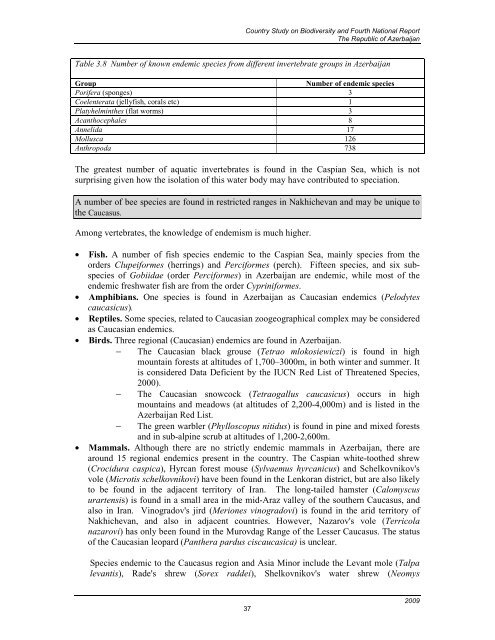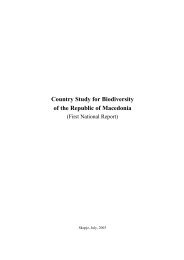CBD Fourth National Report - Azerbaijan (English version)
CBD Fourth National Report - Azerbaijan (English version)
CBD Fourth National Report - Azerbaijan (English version)
Create successful ePaper yourself
Turn your PDF publications into a flip-book with our unique Google optimized e-Paper software.
Country Study on Biodiversity and <strong>Fourth</strong> <strong>National</strong> <strong>Report</strong><br />
The Republic of <strong>Azerbaijan</strong><br />
Table 3.8 Number of known endemic species from different invertebrate groups in <strong>Azerbaijan</strong><br />
Group Number of endemic species<br />
Porifera (sponges) 3<br />
Coelenterata (jellyfish, corals etc) 1<br />
Platyhelminthes (flat worms) 3<br />
Acanthocephales 8<br />
Annelida 17<br />
Mollusca 126<br />
Anthropoda 738<br />
The greatest number of aquatic invertebrates is found in the Caspian Sea, which is not<br />
surprising given how the isolation of this water body may have contributed to speciation.<br />
A number of bee species are found in restricted ranges in Nakhichevan and may be unique to<br />
the Caucasus.<br />
Among vertebrates, the knowledge of endemism is much higher.<br />
• Fish. A number of fish species endemic to the Caspian Sea, mainly species from the<br />
orders Clupeiformes (herrings) and Perciformes (perch). Fifteen species, and six subspecies<br />
of Gobiidae (order Perciformes) in <strong>Azerbaijan</strong> are endemic, while most of the<br />
endemic freshwater fish are from the order Cypriniformes.<br />
• Amphibians. One species is found in <strong>Azerbaijan</strong> as Caucasian endemics (Pelodytes<br />
caucasicus).<br />
• Reptiles. Some species, related to Caucasian zoogeographical complex may be considered<br />
as Caucasian endemics.<br />
• Birds. Three regional (Caucasian) endemics are found in <strong>Azerbaijan</strong>.<br />
− The Caucasian black grouse (Tetrao mlokosiewiczi) is found in high<br />
mountain forests at altitudes of 1,700–3000m, in both winter and summer. It<br />
is considered Data Deficient by the IUCN Red List of Threatened Species,<br />
2000).<br />
− The Caucasian snowcock (Tetraogallus caucasicus) occurs in high<br />
mountains and meadows (at altitudes of 2,200-4,000m) and is listed in the<br />
<strong>Azerbaijan</strong> Red List.<br />
− The green warbler (Phylloscopus nitidus) is found in pine and mixed forests<br />
and in sub-alpine scrub at altitudes of 1,200-2,600m.<br />
• Mammals. Although there are no strictly endemic mammals in <strong>Azerbaijan</strong>, there are<br />
around 15 regional endemics present in the country. The Caspian white-toothed shrew<br />
(Crocidura caspica), Hyrcan forest mouse (Sylvaemus hyrcanicus) and Schelkovnikov's<br />
vole (Microtis schelkovnikovi) have been found in the Lenkoran district, but are also likely<br />
to be found in the adjacent territory of Iran. The long-tailed hamster (Calomyscus<br />
urartensis) is found in a small area in the mid-Araz valley of the southern Caucasus, and<br />
also in Iran. Vinogradov's jird (Meriones vinogradovi) is found in the arid territory of<br />
Nakhichevan, and also in adjacent countries. However, Nazarov's vole (Terricola<br />
nazarovi) has only been found in the Murovdag Range of the Lesser Caucasus. The status<br />
of the Caucasian leopard (Panthera pardus ciscaucasica) is unclear.<br />
Species endemic to the Caucasus region and Asia Minor include the Levant mole (Talpa<br />
levantis), Rade's shrew (Sorex raddei), Shelkovnikov's water shrew (Neomys<br />
37<br />
2009

















